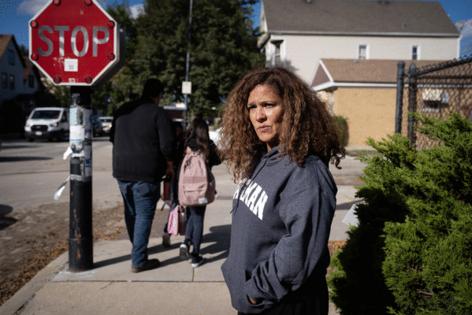Fighting Trump's immigration blitz in Chicago, ward by ward
Published in News & Features
CHICAGO — Chicago aldermen have traditionally measured success by potholes filled, block party bounce houses delivered, votes counted.
But with President Donald Trump’s deportation blitz in full swing, some are adding once unimaginable duties: getting tear-gassed and handcuffed, organizing legions of volunteers, leading local patrols and standing guard near elementary schools.
It’s an effort that has played out outside detention centers and playgrounds, in ward offices, packed auditoriums and in front of news cameras. It has been especially pronounced among the City Council’s progressive Latino members, several of whom hail from grassroots activist backgrounds or represent communities catching the brunt of U.S. Immigration and Customs Enforcement agent efforts.
“We’ll do everything in our power to make sure that ICE is out of Chicago,” Ald. Michael Rodriguez, 22nd, who represents Little Village, told the Tribune on Oct. 3 outside the Immigration and Customs Enforcement processing facility in Broadview targeted for the last month by protesters.
On Oct. 3, those protesters included five from the City Council. They spoke to reporters to demand federal authorities let elected officials tour the locked-down compound.
One, Ald. Byron Sigcho-Lopez, 25th, arrived late to a news conference, a gas mask hanging around his neck. The Pilsen alderman had moments earlier been a part of a crowd heckling passing law enforcement vehicles. “Fascist!” he yelled. He would be hit with tear gas at another protest a day later and retch as demonstrators tried to wash his eyes.
The aldermen were driven to Broadview, they said, by a shared fear infecting their wards. Trump’s “Operation Midway Blitz” raids have made parents uncomfortable dropping kids off at school and bread winners afraid to go to work, braking life in vibrant, historic and economically essential immigrant-filled communities, Rodriguez said.
The Southwest Side alderman called it “terror.” He gestured over his left shoulder, where a federal agent outfitted in camouflage military battle gear stood near a rifle mounted to a sniper tripod pointed toward the tense, but largely peaceful protest.
“It says that the federal government is not on our side, that we are targets,” Rodriguez said. “This isn’t right. This is un-American.”
To be sure, aldermen who count large immigrant communities, immigrant rights activists and wealthy liberals as important parts of their bases recognize that appearing before news cameras in Broadview or setting up forums to help concerned residents organize against ICE tactics is good politics. Showing they’ve done something could help them fend off complaints that they didn’t do enough.
But ICE incursions are understood as an affront to many Chicago aldermen, who have long been described as having the power in their neighborhoods of feudal lords. If that is the case, then many have plainly decided their fiefs are under attack.
Like Rodriguez, they view Trump’s government as a hostile enemy. That opposition, they believe, requires them to adopt roles far outside their typical work.
They are up at dawn to pace around school campuses. They are tracking — and often rushing to respond to — ICE sightings noted in group chats. They are pulling in and training people, an approach aligned with the grassroots organizer background that first won many of them political office.
That’s the spirit that sent Ald. Jessie Fuentes, 26th, into the emergency room at Humboldt Park Health hours after the Broadview protest. Inside, federal agents were detaining an injured man. Fuentes entered and demanded they present a warrant for the man.
“He has constitutional rights. Do you have signed judicial warrant?” she asked. An agent violently spun her and bound her with handcuffs, an encounter captured in a now viral video.
Her fellow aldermen rushed to her, Ald. Anthony Quezada, 35th, all but shutting down his office early to dash over while deploying staff members to nearby elementary schools, another speeding from a doctor’s appointment, others from shifts working alongside hundreds of Northwest Side volunteers for “rapid response” to the influx of ICE sightings that slammed the area that day.
The crowd of elected officials huddled in a circle with Fuentes, who said she had been let out of handcuffs after about 10 minutes. They turned their focus to getting the man detained inside set free.
Beatriz Ponce de León, Mayor Brandon Johnson’s deputy mayor for immigrant rights, waited outside with them. Her heart was breaking with “our communities under attack,” she told the Tribune.
“We will use litigation. We will use advocacy. We will use our community connections to fight back as much as possible,” Ponce de León said.
Her presence was a reminder that aldermen aren’t the only City Hall politicians who cut their teeth with grassroots community action. Johnson, a close ally for the Latino progressives, rose to power as a union organizer and has repeatedly praised their efforts.
After a news conference, Fuentes stood for hours outside the hospital. She read off reports to her staff about nearby street corners where ICE had been spotted: a plant store two blocks away, a day care facility. And she waited for the man.
“We need the legislative bodies in every single sector of government to continue to use every possible tool at their disposal to protect our folks,” she said.
The next morning, Ald. Andre Vasquez, 40th, bounded along the sidewalk outside Mather High School like a dog unleashed in a park. He strode to the back of a line of people that spewed out from the school’s entrance. It jutted out to the street, then half a block down North Lincoln Avenue before continuing down an alley to wrap around the school.
Vasquez had expected some 300 people to show up to his West Ridge “community defense” workshop on the morning of Oct. 4. He got well over double that, enough to fill the school’s auditorium.
Inside, the former rapper asked the crowd who in the room felt anxious. Nearly every hand went up as he tried to harness the latent energy. He led a chant: “We keep us safe, we keep us safe.”
“You are watching a stress test for your whole government and democracy. And we’re also identifying the spots that can be filled,” he said. “I’m here to recruit you.”
Megan Augustiny, an English teacher at Gage Park’s Solorio Academy High School, teared up as two Latina Mather students told the crowd about their fear. She’s been feeling helpless herself, she said.
Augustiny came to the training to prepare for a new role in her school’s sanctuary team, tasked with watching out for immigration agents during drop off and pick up, she said. In her own classroom, she’s been bottling up how she’s feeling, she added.
“It’s been weighing on me a lot. … It’s really nice to know that so many people are upset as well,” she said. “I always want to feel like I’m at least trying to do something.”
The crowd split into focused training groups: mutual aid in the library, “Know Your Rights” business canvassing in one classroom, communications and court support filling another, the walls lined with a standing-room-only crowd.
A larger “ICE watch” group stayed in the auditorium to study the basics of filming federal agents in action. The crowd learned to take face identification off their phones to make it harder for the agents to unlock them if they get arrested, and to take out their headphones, find what’s happening around them, take a breathe and decide what action to take.
Vasquez, who has made a determined effort to post about Trump’s deportations on social media, in part with a newly purchased microphone, told the Tribune later he hopes to replicate the popular training in other wards. The more people show up, the more “breathing room” there is for everyone else, he said.
“To have that many people who believe and want to do something in this moment, it’s like all the hope in the world, in a world that we’re actually facing,” he said. Like other aldermen, he carefully noted that his political organization, not his official ward office, was carrying out the work.
While Latino progressives have led the charge, even many City Council moderates have shared information on training and rapid response groups. Still, when a majority of aldermen condemned Fuentes’ arrest, the signatures of 13 aldermen were notably absent.
Some aldermen have said little since Trump’s focus turned to Chicago, including Ald. Greg Mitchell, whose 7th Ward includes the South Shore apartment complex dramatically raided by FBI agents earlier this month.
Ald. Raymond Lopez, 15th, a determined Johnson opponent who has vocally and uniquely criticized the pushback against Trump, sent the president a letter Friday criticizing Democratic politicians who “are refusing to work with your administration for the good of their constituencies or the nation, simply because you are at the helm.” He called on Trump to give legal status to the millions of undocumented American residents with no criminal records.
Ald. Rossana Rodriguez-Sanchez, 33rd, has fielded her own flood of volunteers. The school “corner watch” program she helps organize is filling every slot needed in her ward days in advance: about four people per school, at a dozen locations, twice a day, every day.
Parents lined up and waited for their kids outside Albany Park Multicultural Academy last Tuesday. One child played alone on the playground, navy rubber padding below him as he lingered by a royal blue slide.
Rodriguez-Sanchez walked through the neighborhood, circling around the school as she looked for trouble. Along the way, she found volunteer Caitlyn Cerza standing at the intersection of North Spaulding and West Lawrence avenues, her miniature dachshund, Squiggles, at her feet.
Cerza said video of someone being “snatched” by federal agents a block away days earlier had shaken her. It was her first shift on the ICE detection program she learned about through the social media platform TikTok.
“It’s easy to feel isolated,” Cerza, 35, said. “So if there’s a small thing that you can do to get out there and just meet people and protect them at the same time, that’s an easy win.”
Schools are a top priority for Rodriguez-Sanchez. Beyond education, they offer food, health clinics and counselors, she said. Like at other campuses, her outside team covering street corners a few blocks away complemented a Chicago Teachers Union team monitoring from the building.
The various Trump pushback efforts popping up throughout the city were in part informed by “mutual aid” support efforts made during the early pandemic, she said. In her own life, taking direct action has been an instinct since she was 6, when her father helped her Puerto Rican town push for restored water access, she said.
She wants people so connected now that they would pop out of their homes if ICE arrived on the block, she said.
“We really wanted people to feel confident that they could continue to come and take their kids,” she said. “There are basic things that we can all do, just being outside, with your eyes out.”
She waited outside Hibbard Elementary School in a crowd of parents. Children jumped down the three steps outside the brick building, many wearing backpacks half as big as them.
As she looked around, she pushed back on the idea that aldermen like her were leading the pushback. She was just providing the resources and a format, she said.
“People are driving this, and it is a really beautiful thing at a moment when it is so hard to have hope” she said.
Her son came out of the school’s entrance and ran toward her. He launched himself into her arms.
____
©2025 Chicago Tribune. Visit at chicagotribune.com. Distributed by Tribune Content Agency, LLC.







Comments